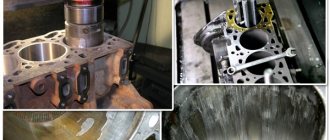Many car owners are faced with the problem of repairing their “iron horse”. It happens that a problem has arisen, but there is no money to pay for the work of the master. So you have to independently delve into all the intricacies of the structure of the various components of the unit. In such cases, there is one more problem: there are fewer and fewer real experts in repairing cars of any brand. But the work done personally by the driver will be of high quality, because it is done for oneself. However, all car enthusiasts are at risk of doing this, and not every problem area can be repaired with your own hands, especially if required gearbox repair and other complex units.
Today we will try to understand the algorithm for the gearbox repair process. And not only mechanical, but also automatic. You should be warned in advance that this is not an easy process, and do not listen to those who will assure you otherwise! They either do not understand anything about the structure of the box, or they looked at the repair from the outside.
Before you begin repair work, carefully and thoroughly study those pages in your car’s operating manual, which describe not only the operating principle, but also the internal structure of the gearbox. If you don’t even have initial experience, then you shouldn’t start right away with a major overhaul. However, with guidance at hand, most men can fix minor problems that arise on their own.
Possible malfunctions in a manual transmission
The most typical problems may be the following:
- Difficulty when engaging one of the gears.
- One of the gears switches off spontaneously (knocks out).
- The appearance of uncharacteristic noise in the box.
- An oil leak has been detected.
- The gearbox often overheats. We hope that all owners remember that the oil level in the box is checked after every 15-20 thousand kilometers of the car.
The discovery of these problems serves as an indicator that the transmission of your car needs to be repaired, and you should not delay it. A problem that is not corrected in the early stages can cause a major repair in the future, and this is a repair of a different complexity that requires contacting service centers with the appropriate payment for their services.
Mechanical transmission repair
Repair of a gearbox of this type (we'll talk about modern cars) is usually carried out in a specialized car service center, and although the operating principle and basic structure of modern manual gearboxes are not much different from their predecessors, the production technology, the accuracy of the work, the use of new materials and technologies are still , which allow them to withstand heavy loads with the same dimensions, allow us to say that modern repair of gearboxes, in particular mechanical ones, is not possible, only with a screwdriver and a hammer in hand.
Repair of a gearbox, in particular mechanical ones, begins with identifying the causes of the malfunction, and for this it is necessary to repair all the main parts of the gearbox. Housing, synchronizers, forks, shift mechanism, clutches, check seals and much more, this requires special equipment and special stands.
Many car repair shops, due to the fact that they do not have qualified personnel, even if they have the equipment, refuse to repair the gearbox, since it is difficult, and now everyone values \u200b\u200bthe image. Therefore, under any pretext, in this case, you will receive a cultural refusal.
But if a car service center has a good specialist who repairs the gearbox, he will be able to immediately determine the cause of the malfunction, since they are mostly typical.
After disassembling and identifying faulty parts, a good car service center will always point you to those parts that are recommended for replacement. And don’t think that they want to make money from this.
If your car has several tens of thousands of kilometers and the gearbox has failed, then believe me, there are also parts in the gearbox that are at the limit of wear. In this situation, the expression “the miser pays twice” is very relevant.
The most difficult moment in repairing a gearbox, and not only a mechanical one, is its assembly, during which shafts, bearings, gears are installed, everything is ground in and precisely adjusted.
In the future, the manual transmission must be installed on a special stand, where the gearbox is fully run-in, its operation is checked, the presence of noise, oil leakage, how the gears are engaged, etc.
If all stages of repair and testing went well, then the manual transmission is installed on the car and the rocker is adjusted.
However, before this stage, remember, just in case, about the car’s clutch. What condition is it in, is it worth replacing or repairing? After all, gearbox repairs and removal are not carried out every day.
After the gearbox repair is completed, do not forget to celebrate the preparation of all the necessary documents, from the warranty certificate to the certificate of completion of work. After all, repairs are not cheap and a warranty will not hurt in any way. Only after this will the gearbox repair be completed for you.
Possible malfunctions of the machine
Foreign-made cars most often suffer from breakdowns, and it is not always worth starting to repair them yourself. This can lead to numerous problems in the event of further contact with car service centers of this manufacturer, so you will have to answer this question yourself, taking into account your skills and capabilities.
With an automatic machine, most often:
- The electronic control unit fails, which causes problems with the process of switching not only “upper” but also “lower” gears. Often they may stop switching speeds from 1 to 4.
- Troubles can begin due to violation of the rules of car operation: if you braked sharply, tried to quickly change gears, or put the car in reverse when the car was not completely stopped.
- Cars with automatic transmission are extremely demanding on the quality and quantity of oil that you pour into it. If there is constant overfilling or underfilling, malfunctions may occur and the gearbox will need to be repaired.
All car owners know that manual transmissions are much easier to repair than automatic ones. Before you start repairing the machine, you should think several times and listen to the opinion of the experts at the service center. Many parts are expensive, not only new ones, but also used ones. And the center’s technicians may refuse to complete the repair work if they see that someone has been “digging” in the car before them. Therefore, the decision is up to you.
Automatic transmission repair
It is better to carry out automatic transmission repairs yourself, having at hand the original manual and a printed diagram of the gearbox. First you need to inspect all systems that service the gearbox, mounts and blocks. Then we begin the repair. For this:
Assembly occurs in reverse order.
There are certain points that it is advisable to take into account during repairs. Often the transmission problem is related to the filter. You won't be able to change it without removing the valve body. And when you remove it, the gasket breaks. To replace it, you will need to completely disassemble the valve body. The same applies to the accumulator spring from first to second gear. A special limiter does not allow it to be removed without disassembling the valve body. All valve body gaskets are very similar, do not mix them up. When assembling the valve body, we tighten it with a torque wrench. It’s important not to over-tighten here.
Algorithm of actions when repairing a manual gearbox
- When carrying out repair work on the gearbox, you should strictly adhere to the principle: all removed elements are placed in the order in which they were removed; you should not rely on your visual or mathematical memory. It is recommended to replace the entire main gearbox shaft and bearing. In addition, on new parts, the seals and washers in the sealing areas should be replaced, because as a result of disassembly and then reassembly, the gaps and gaps increase.
- In the gearbox, we replace the part that has become unusable.
- We assemble and mount the gearbox in the reverse order, and at this point the gearbox repair can be considered complete.
It is advisable to carry out repair work on automatic transmission (if you have not tried this before) at a service center. If you yourself have to replace or add oil to a certain level in the box, remember that you should not overfill or underfill it.
Finally, I would like to wish that the movement of your car is always even and smooth and that you do not have to deal with transmission repairs!
Kolodiychuk Andrey
, especially for
Manual transmission diagnostics
In order to identify manual transmission faults, you need to conduct a thorough diagnosis of this unit. After all, when starting a manual transmission repair, focusing only on your guesses and assumptions, you can waste time and money to no avail, changing serviceable manual transmission parts one after another.
Since the devices of any manual transmission are approximately the same (domestic cars and foreign cars), diagnostics are carried out using the same algorithm. If your car is equipped with an on-board computer, then most errors associated with the operation of the manual transmission can be deciphered. It also happens that errors do not indicate a specific malfunction, but only indicate a general breakdown.
Manual transmission breakdowns can be different, but they can be divided into several types:
A simple oil flush often helps to avoid problems with manual transmissions. There is no need to dismantle the box during this procedure. All you have to do is drain the old oil and fill in new oil. After this procedure, you should start the car and drive at a calm pace. This procedure will help the new oil penetrate into all places of the gearbox. Sometimes you have to wash it several times, since there may be a large amount of dirt inside the box.
Now stores sell special restorative additives for manual transmission oil. They should not be abused, since their effect at the checkpoint is not always predictable. It is better to fill the additive for a while, and then drain it along with the oil.
What is important to know about a manual transmission
There is no need for us to consider in detail how the manual transmission works. Let us touch superficially only on the main points that influence the repair of a mechanical transmission.
The main purpose of the gearbox (Gearbox) is to transmit power and torque from the power unit in a variable speed range. To change the number of rotations, pairs of gears are used that have different gear ratios. Due to them, 1,500 revolutions can easily become several dozen rotations of the drive wheels, while the torque will increase.
The algorithm of operation is like that of a bicycle: the start of movement is on a small “asterisk”. Next it accelerates to 40 km/h, then switches to the next pair of gears, which have a lower gear ratio. Thus, the speed increases. You can switch four or five times. Today's manual transmissions mostly have five- or six-speed gearboxes.
Due to the engagement of the corresponding gears located on the shafts, torque is transmitted to the manual gearbox. There are two- and three-shaft boxes. The first device consists of a drive (primary) and driven (secondary) shaft. In the second, torque is transmitted through an intermediate shaft, which is located between the primary and secondary parts. The gears that are located on the shafts are constantly meshed. In this case, all pairs rotate freely, except for one, which was chosen as the working one at this time.
In order to select a pair, there is a special coupling called a synchronizer. It connects the gears and the driven shaft to engage the desired gear. You move the lever in the gearbox inside the car, and with the help of the power fork and synchronizer, the desired gear is connected to the driven shaft, and it receives torque from the power unit, that is, the wheels also begin to spin.
Manual transmission is more popular than automatic transmission. Let's list the positive aspects of a manual transmission (MK):
- Price. By buying a car with a manual transmission, you save from 50 to 100 thousand rubles.
- Fuel consumption is much less.
- Repair and maintenance are not difficult.
- Spare parts and consumables are inexpensive.
- The efficiency is very high.
- Transmission components and elements are of increased strength and reliability.
- Adaptability to high temperatures and torques.
The advantages listed above make a manual transmission the most popular when buying a car. Different types of vehicles that are equipped with MK have similar problems due to the same design of the mechanism.
Types of defects in a manual gearbox and methods for eliminating them
We will analyze in more detail the problems that are identified during the diagnosis of MC, and ways to eliminate the problems.
1. The most common problem that occurs when driving a car with a manual transmission is increased noise in neutral and a specific squeak during shifting . Typically, such a defect is a consequence of a low level of technical fluid in the manual transmission or its absence.
Step-by-step repair of a manual gearbox
If you have problems with shifting gears or they get knocked out while driving, then the car’s manual transmission needs to be repaired, because operating such a vehicle is uncomfortable and dangerous. You need to seek help from professionals. However, not all service stations perform this type of work. If your car is nevertheless taken to a service station to replace parts, then there is no guarantee that the mechanics will do everything in good faith. They may tell you that they installed new elements in the entire box, but in fact they only changed the gear, which has exhausted its service life.
If you are familiar with the structure of the machine, have a garage and the necessary tools, then it is more advisable to repair the box yourself. As a result, you will not only get a repaired car, but also save a significant amount. Remember that the gearbox weighs a lot, so you need an assistant for the job.
Before starting manual transmission repairs, you need to remember the safety rules and dismantling of complex devices (which includes the gearbox) and, based on them, perform further actions:
- The transmission is a set of mechanisms that have a decent weight (especially in a vehicle with a powerful engine), so when removing the unit you need to be careful and careful. You can use someone else's help when removing the gearbox or throw the chain over the beam in order to carry out the dismantling yourself, in accordance with the rules for operating the levers. If you chose the second method of disassembling a manual transmission, then you need to position the car so that the beam is just above the engine compartment. Next, throw the chain over the beam and remove the gearbox from the mounts (usually you need to move the motor from its mountings) and, using steel hooks, lift it to the desired height. The process becomes much easier due to proper weight distribution.
- When disassembling a transmission, it is very easy to get confused in the large number of elements that make up it. Accordingly, the removed gearbox parts must be laid out in a strictly defined order. In other words, they need to be laid out in such a way that the reverse sequence principle works during assembly. In this case, you will not have any problems with mounting and installing the device in its place.
- Mechanical transmission repair is the replacement of a part that has failed. No other actions should be taken, because the mechanism is quite complex and other problems can only be identified through diagnostics.
We recommend carrying out repairs in the following sequence:
1. Remove the mechanical box.
Before you begin dismantling the gearbox, you need to check the cables, levers and racks. They must be well secured and move smoothly. Perhaps your car was jerking as a result of poor-quality connection of parts and you just need to work them out or tighten them.
Step-by-step process for removing a manual transmission:
- (before starting work) place stops under the car wheels that will prevent the vehicle from moving, and disconnect the battery terminals.
- Conduct a visual inspection of the mechanism and outline an action plan.
- Drain the full amount of oil from the gearbox into a special container.
- Any parts that could interfere with the removal of the device must be disconnected.
- Place the engine and manual transmission on supports that will prevent the mechanisms from falling to the ground. If this suddenly happens, damage may occur in the gearbox, making further repairs useless.
- In a car with front-wheel drive, you need to unscrew the wheels and remove the CV joint. If you just can’t get it, then a pry bar will help you.
- For a rear-wheel drive vehicle, you need to remove the driveshaft.
- Next, you need to disconnect the gearbox from the engine and support pads.
- Remove the manual transmission. If you can’t do this, then use a mount.
- Clean the gearbox from dirt.
- Open the manual transmission and carefully examine the internal arrangement of the elements.











